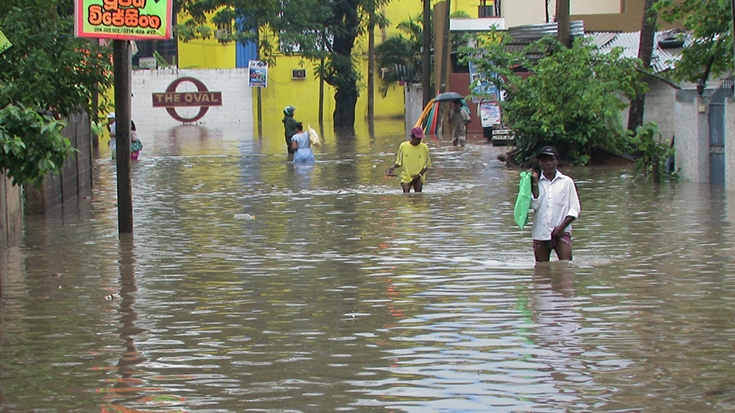Colombo has a water problem. The city faces increased risk of devastating floods and the World Bank is working with the government to strengthen the Sri Lankan capital’s defenses, safeguarding the livelihoods of 2.5 million people and the economic health of the entire country.
The World Bank is lending $213 million through the Metro Colombo Urban Development Project after severe flooding in 2010 exposed the city’s vulnerability to shifting patterns of torrential rain, which experts link to climate change.
The bulk of the loan will be used to bolster Colombo’s resilience and its ability to prevent floods in the future by improving the network of canals, pumps, culverts and drainage channels that form the backbone of the city’s flood and drainage management infrastructure.
This is an essential public investment. Rainfall frequency has almost doubled in Colombo over the last 30 years, suggesting that floods of this scale will happen with increasing regularity in the future, each time with potentially crippling economic consequences.
The city is built on a low-lying river estuary overlooking the sea. It was effectively shut for an entire week by flooding in 2010. The cost of that episode is conservatively estimated at $50 million and it could have been much worse. The Colombo metro area generates half of the country’s gross domestic product (GDP). Repeated interruptions to the smooth functioning of the city represent a real threat to national prosperity and the competitiveness of the capital region.
To help fix this, the Metro Colombo project will allocate over $93 million to enhance the drainage capacity of the Colombo water basin; rebuilding and improving a series of major canals, floodgates and drainage tunnels to significantly expand flood outflows. This will get excess water out of the system faster.
There is another challenge. In addition to changing weather patterns, the basin has also lost about 30 percent of its water storage capacity over the last decade due to city growth. So part of project focuses on demonstrating how restoring lakes and wetlands that act as natural retention areas for sudden deluges could further increase the city’s resilience to today’s floods and tomorrow’s unpredictable climate changes
Wetlands, in particular, are a promising green investment because they act as natural water treatment plants and help lower local temperatures, reducing the need for air conditioning. They can also become valuable recreation resources for local residents and for tourists, who are an increasingly important source of Sri Lanka’s foreign exchange earnings.
One way to think about the project is to divide the Colombo catchment area into three sections. In the upper part of the area, the project’s goal is to improve the network’s ability to divert excess water into the basin’s river.
In the catchment’s mid-section, the idea is to retain excess water in wetlands and lakes, to prevent it from advancing any further and overwhelming the lower network.
In the lower part of the catchment area, the goal is to flush water through the system as quickly as possible by improving Colombo’s outfalls to the sea and Kelani River through tunnels and pumping stations. .
The project allocates $28 million to improve the micro-drainage system which funnel water into much larger canals that discharge into the sea within the area administered by the Colombo Municipal Council, focusing on 15 priority hot-spots that are particularly prone to floods.,
A further $14 million is earmarked to improve drainage management. This includes buying machinery to stop canals getting clogged up with rubbish and financing a pilot water-taxi system – an appealing public transport option in a city that suffers serious congestion.
The program provides $11 million to complement flood-reduction measures around Beira Lake Linear Park and the rich wetlands of the Beddagana Park, near to the Parliament.
At Beira Lake, public access to the lake front will be assured by building bank-protection walls and constructing a 4 km long promenade that incorporates footbridges and playgrounds for kids. Money is also set aside to restore the lake’s historic McCallum Lock Gates, part of the city’s cultural heritage, which will become a museum presenting the history of canals and waterways in Colombo..
At Baddagana Park, the goal is to demonstrate how to protect this wetlands sanctuary of 32 hectares from further encroachment from the growing city, preserving it as a flood-retention area and developing it as a recreational resource by establishing nature trails, bird-watching hides and a jogging trail.
The project also invests $50 million in urban development and infrastructure. The main goal of these measures is to build on-the-job capacity among municipalities in the Colombo metro area to work better together in operating and maintaining public infrastructure. The investments, which are designed to foster a sense of ownership among the local authorities, include improvements to street drainage, purchasing equipment to bolster the trash collection capacity, and landscaping selected municipal parks to demonstrate how they could also double up as wetlands used for flood-retention.
Some of this money will be used for specific urban improvements projects, including upgrading the Town Hall Square, through which 60,000 people pass every day, and the nearby Vihara Maha Devi park and several other parks. In addition, overhead foot-bridges bridges will be built at key intersections, 11 km of sidewalks will be upgrade, 10 km or roads will be repaved, street lighting will be fixed on 10 streets and public toilets will be upgraded in 14 locations.


